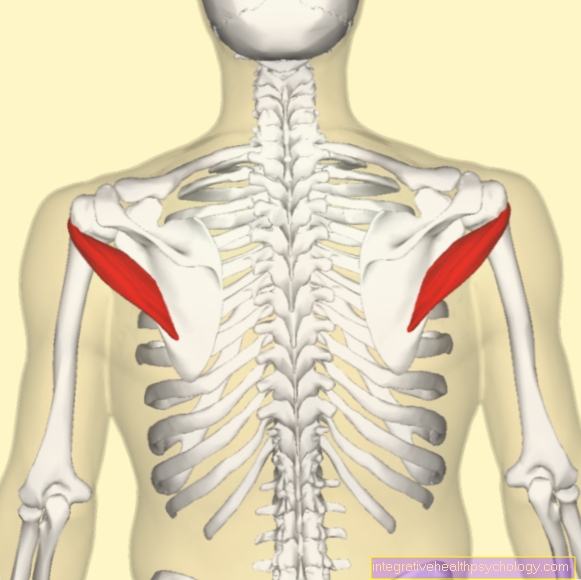Endurance sports and fat burning
Synonyms in a broader sense
Endurance, jogging, jogging, running, running, fatburn, marathon, triathlon
Definition of endurance sport
Endurance sport is the ability to maintain a sporting performance for as long as possible, to hold back the fatigue caused by sport for a long time and to recover the body as quickly as possible after sport.

Definition of fats
Adipose tissue is for our body above all one Energy storage. Compared to a motor, the human body also needs energy to perform.
In addition to the carbohydrate store and the creatine phosphate store (Creatine) is the fat store Basis for endurance sports.
For more information, check out our main article as well Fats in the human body
Definition of kilocalories
Kilocalories are the measure used to determine food intake (cheeseburger = 310kcal) and energy burn (35 min To run / Jogging = 310kcal).
If more kilocalories are burned by the body than absorbed through food, one speaks of one negative energy balance.
This negative energy balance is the basis for the desired weight loss.
For more information, check out our main article as well Kilocalories
Energy supply
The human body works much like an engine, it needs it fuel to perform.
In our case, performance is that endurance.
However, unlike the engine, the body does not only have a petrol tank, but stands for it three types from “fuel“ available.
- The smallest energy store in the human body is that Creatine Phosphate Storage (KrP), he provides his energy immediately and is therefore required for very short and very high loads (sprinting).
- The second, larger memory consists of sugar (Glucose / carbohydrates), and is important for endurance exercise with medium intensity (running at approx. 11 km / h).
- The third energy storage is that Fat storage.
The fat storage of a normal weight man is 100,000 kcal of energy, which is the equivalent of around 30 Marathons would be enough.
Fats are though very energetic and even in marathon runners in excess, but it is very difficult for the body to convert it into energy (Fat metabolism).
This is also the reason why the human body uses sugar when it is exposed to higher levels.
If you start endurance training, the sugar is not burned first, as was previously assumed, but all energy storage become at the same time open.
However, since the conversion of fat into energy more expensive is and thus takes longer, the body saves sugar for itself more intensive services (Running / jogging at 11 km / h), and thus the body burns at lower loads (Walking or slow running up to 6 km / h) mostly fat.
Since the Fat metabolism by regular endurance training (To run, swim, To go biking) is improved, it is especially important in the beginner area to work with very low intensities to train.
To the correct intensity range Choosing in training offers a more targeted one Lactate level test on.
offers you the possibility of a targeted Performance diagnostics in the Orthopedicum Frankfurt practice.
Fat burning
Burning fat is the decrease in body fat tissue.
The human body burns energy around the clock, even with no physical activity a man of normal weight burns around 1700 kcal and women around 1500 kcal per day (Basal metabolic rate).
Read more on the topic: Lose weight by burning fat
The body burns fat not only during exercise (running, swimming, etc.), but especially after exercise.
The decisive factor for weight loss is therefore not how much fat I burn during my training, but that I increase the basal metabolic rate of kilocalories through exercise.
So you have to increase the daily metabolic rate of calories (from 1700 kcal to 2100 kcal) to specifically lose weight / reduce excess weight (Read about losing weight without hunger.)
Further information is available from:
- Lose weight with exercise
- Weight training and fat burning
- How can you boost fat burning?
Example basal metabolic rate
Person X does not do sports and burns 1500 kcal per day. He consumes exactly this 1500 kcal through food. It is neither increasing nor decreasing.
If he starts endurance training, his basal metabolic rate increases to, for example, 2000 kcal and the person loses 500 kcal daily.
It might be of interest to you too: Fitness diet
Endurance sports

The most common Endurance sports counting To run (Jogging), biking, swim, Nordic walking, Walking and skating.
Who one Endurance training in the gym preferred, his exercise program should be on one Cross trainer complete.
But which endurance sport is the most effective for me?
Most effective to burn calories is running. An average of 550 kcal / hour are burned, followed by Nordic walking (450 kcal), Breaststroke (435kcal).
The perfect endurance sport does not exist like this.
Everyone prefers certain sports, this also applies to the choice of endurance sports.
Those who prefer to run should also run.
However, it should be noted that not all sports are suitable for everyone are.
Obese it will certainly cause problems in the beginning in sports that she does have to carry their own body weight (especially running).
Here it would be recommended to do sports like swim or To go biking to choose.
In addition, the Joint loading while running 3 times as high as when walking, whereby the human body is also adaptable when it comes to stress on the joints (if you run regularly strengthens his joints, and reduced the risk of joint wear like arthrosis).
Endurance sports such as skating or Nordic walking are very demanding in terms of coordination and you have to first learn the right technique to be able to train effectively.
So it's on personal settings and possibilities to pay attention.
Overview of endurance sports
Sport:
1. Running / jogging
- Possible applications: (high)
- material/ Cost: (high)
- Calorie consumption: (very high)
- endurance: (very high)
- burden the joints: (very high)
- involved muscles: (medium)
- Risk of injury: (low)
- Physical requirement: (high)
- suitable for Beginner: (rather no)
2. Biking
- Possible applications: (medium)
- material/ Cost: (high)
- Calorie consumption: (medium)
- endurance: (medium)
- burden the joints: (very low)
- involved muscles: (low)
- Risk of injury: (medium)
- Physical requirement: (low)
- suitable for Beginner: (Yes)
3. Swimming
- Possible applications: (low)
- material/ Cost: (low)
- Calorie consumption: (high)
- endurance: (high)
- burden the joints: (very low)
- involved muscles: (high)
- Risk of injury: (very low)
- Physical requirement: (low)
- suitable for Beginner: (Yes)
4. Nordic walking
- Possible applications: (high)
- material/ Cost: (low)
- Calorie consumption: (medium)
- endurance: (medium)
- burden the joints: (low)
- involved muscles: (high)
- Risk of injury: (very low)
- Physical requirement: (low)
- suitable for Beginner: (Yes)
5. Skating
- Possible applications: (medium)
- material/ Cost: (medium)
- Calorie consumption: (medium)
- endurance: (medium)
- burden the joints: (low)
- involved muscles: (medium)
- Risk of injury: (high)
- Physical requirement: (medium)
- suitable for Beginner: (rather no)
Endurance training at home
For a Endurance training at home equipment is usually required because nobody has enough space at home to set up a swimming pool or go jogging.
Many people who want to train at home buy into it Exercise bike or a Treadmill.
There is also the option of getting one trampoline to buy to jump and run on.
Small round mini trampolines are already available with a diameter of one meter, so they are space-saving.
All of these possibilities can give us keep fit and thus also the Increase fat burning.
This is also a very effective way of burning fat and doing endurance sports Jumping rope. In addition to being effective, jumping rope is also one of the cheapest variantsto do endurance sports at home.
Combined with a healthy and balanced diet the options listed here are ideal for endurance sports and fat burning at home.
Training planning

In order to specifically improve endurance, certain training rules must be observed:
- Train - pause - train.
The desired training effects only occur in the times between training, which is why this time is of particular importance. For beginners, at least 24 hours applies Break to be observed after training. - Those who train improve their performance.
Thus, the intensity of the training must be continuously adapted to the level of performance. - To train effectively, you have to regularly be trained.
20 minutes three times a week is better than 60 minutes once a week. - The workout as versatile as possible shape. This doesn't just apply to them intensity (running fast or slow, jogging / cycling) and the Training type (Running, swimming ...), but also for the training course (Different routes choose).
- Especially in the beginner area it is important and at the same time difficult right intensity to choose. It is particularly recommended here with one Heart rate monitor to train.
1 week
- Monday: to jog 45 min low intensity pulse 100-120
- Tuesday: Break
- Wednesday: To go biking 45 min medium-high intensity pulse 150-170
- Thursday: Break
- Friday: jogging 45 min medium intensity pulse 130-150
- Saturday: Break
- Sunday: Walking 30-40 min medium-high intensity pulse 150-160
2 weeks
- Monday: to jog 45 min low intensity pulse 100-120
- Tuesday: Break
- Wednesday: To go biking 45 min medium-high intensity pulse 150-170
- Thursday: Break
- Friday: jogging 45 min medium intensity pulse 130-150
- Saturday: Break
- Sunday: Walking 30-40 min medium-high intensity pulse 150-160
3 week
- Monday: Break
- Tuesday: jogging 30-40 min high intensity pulse> 160
- Wednesday: Break
- Thursday: Break
- Friday: jogging 60 min low intensity pulse <110
- Saturday: Break
- Sunday: Walking 30-40 min medium intensity pulse 130-150
4th week
- Monday: jogging 40-60 min low intensity pulse 100-120
- Tuesday: Break
- Wednesday: To go biking 45 min medium intensity pulse 130-150
- Thursday: Break
- Friday: Walking 40 min low intensity pulse 100-120
- Saturday: Break
- Sunday: jogging 30-40 min medium-high intensity pulse 150-165
Would you like to improve your endurance performance and don't know exactly how?
Then read our article on this: Endurance Performance - How To Improve It
Training implementation
Overcoming teething problems
In order to avoid possible risks, you should have a medical examination before starting any endurance training.
Also note our topic Performance diagnostics and Endurance performance diagnostics
The performance diagnostics can also be used to demonstrate the training effect on improving your endurance values.
- Train them not to the point of physical exhaustion.
- You sit down realistic goals.
- Run / jog slower and shorter than you intended.
- Choose flat terrain and avoid steep climbs.
- Look for like-minded people who are at a similar level of performance as you.
- Place them special times where and when to do endurance sports.
- Do you think ...? Find no excuses against sport, but reasons for motivation
- If you get bored while exercising, you should Make training more versatile. Change the sport or the route.
- If, despite training, you no longer have any increase in performance, then you should change the training plan. If you have run mostly long stretches with low intensity, you should choose shorter stretches with higher intensity.
- If training is nothing more than torture for you, then choose the sport that best suits you and reduce the intensity.
Endurance sports for high blood pressure
Sports can also contribute high blood pressure positive developments cause.
If the high blood pressure is still in its early stages, it can even return at normal level be lowered. Thus it can be partially or even entirely renounced medication become.
In this sense, sport by no means only relates to high-performance sport, but to them Change of movement pattern and exercise can be beneficial for high blood pressure and health.
First of all, they are good for the cardiovascular system Sports with moderate stamina, such as jogging, swimming, cycling and cross-country skiing.
Sports like tennis and ball sports can also be practiced outside of competition conditions as long as no extreme load peaks occur.
Endurance training can do that Blood levels of stress hormones (especially from cortisone) reducewhich may be responsible for high blood pressure.
It also increases Stroke volume of the heart that Oxygen consumption is optimized that Cardiac blood flow increases that Cholesterol levels in the blood can be lowered and Heart rate and Blood pressure can also be reduced.
The effects of endurance training that takes place three times a week and lasts about 45 minutes are Lowering blood pressure up to 20 mmHg, Lowering the exercise heart rate by 20 percent and Increase in cardiac output.
The training should therefore always carried out and continuously adjusted become.
The effects of exercise on the body are making itself felt also with fat burning noticeable. Of the Metabolism is boosted and the Fat burning is increased.
Thus, burning fat can make a good contribution to weight loss.
Endurance sports with a cold

A cold, i.e. an infection of the respiratory tract, which is usually caused by viruses, can vary in severity and usually heals spontaneously after one to two weeks.
Since a cold can develop differently depending on the virus, those affected can also feel differently battered or fit. In any case, it is important to allow your body to rest at the beginning so that the immune system can react appropriately to the infection and the cold is gone as quickly as possible.
Because the immune system is already busy with the common cold and may be weakened as a result. Endurance sport, as a further stress factor for the body and the immune system, would impair the immune defense against the common cold, which is actually important at that moment.
If a fever occurs as a reaction to the viral infection, you should definitely not do any sport, as the immune system cannot suppress the virus and it can spread further in the body.
In the worst case, heart muscle inflammation can result. It is generally recommended that you refrain from endurance sports, especially in the first week after the onset of the illness, and only start again gradually when you feel really fit yourself again. In case of doubt, it is better to forego endurance sports once too much, since the body could possibly use up important energy reserves to fight the common cold through physical activity.
Then it could happen that the duration of the cold is stretched a little longer. However, it is not that exercise is absolutely forbidden if you have a cold with mild symptoms. It can be practiced without harming the body. However, you have to try to assess the state of health of your body and the resilience yourself. In addition, the physical strain in sport always depends on the type of sport, the exercise and your own fitness, so you cannot generally make the same decisions for all types of sport.
However, the following things should be noted:
Since the airways are stressed by increased breathing during exercise, a cold can lead to breathing problems and increased symptoms, such as increased secretion flow or increased swelling, if the mucous membranes are already severely swollen and mucous. You can also feel more exhausted than usual after exercising. Therefore, one should not completely exhaust oneself with a cold. However, very light sport can also strengthen the immune system and prevent colds if you are regularly active in a healthy state.





























